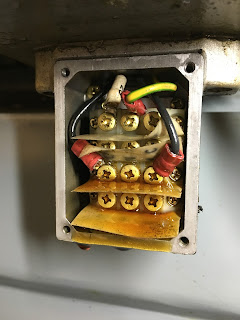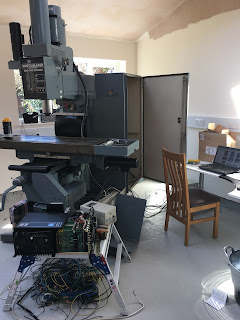So I need a soft start circuit that won't take me a month to construct or cause trouble with The Internal Controller, viz-a-viz the cost. Industrial motor / transformer soft starts are expensive and I didn't have one on the shelf last time I looked.
There are generally 2 issues with turn-on of transformers - the inrush surge due to the large DC bus capacitance (in this case) and the occasional transformer saturation caused by the remanence (residual magnetism) that was left in the transformer laminations at the instant the power was interrupted when the power was last turned off. Transformers generally run very high magnetisation flux swings (core losses aren't generally a problem), so periodically (and the timing is essentially random), you get a very large overload at turn-on if the initial flux swing added to the initial remanence exceeds the saturation flux. If the circuit breaker / fuse doesn't trip or blow, the flux will then settle down and everything will be fine again.
I've been here before. My massive (400kg) Miller-Interlas AC/DC TIG welder is basically a giant 50Hz switched mode power supply, complete with 2 massive mag amps and an even more massive output filter inductor. It's pretty cool that the only active (semiconductor) components are 4 stud diodes - that's got to be the simplest regulated SMPS you can make. Full load current from the mains is about 50-60A with over 200A output. The current surge at turn-on when the transformer saturated periodically was too big even to be masked out by using a 63A Type D MCB, so I had to make a soft starter for it.
There are generally 2 types of soft starter - phase control using triacs (the duty cycle starts at zero and gradually opens up to 100%) and a series precharge resistor that is switched out by the main contactor after a short delay. The phase control circuits are pretty complex if you are after a quick solution and of course the components are f expensive. Even for a single phase version, the power components wouldn't be cheap.
The switched resistor circuit sounds dead simple and in some ways it is. For the welder, I was able to simply delay the closing of the main contactor while a small-ish resistor got the flux sort of balanced around zero over a few cycles. But if the resistor is too big, you don't get enough flux balancing to reduce the remanence enough to avoid saturation when the contactor finally closes. And if it's too small, you don't get much of a soft start. So you have to figure out the sweet spot and nobody will tell you where that is - requires some experimentation. I used a Finder time delay relay (something like this) to delay the main contactor and a metal clad resistor across the contactor at power on.
This sounds like the right approach. I'm sure I bought a couple of spares at the time but can I find them now....





















































